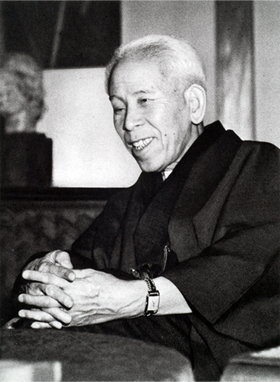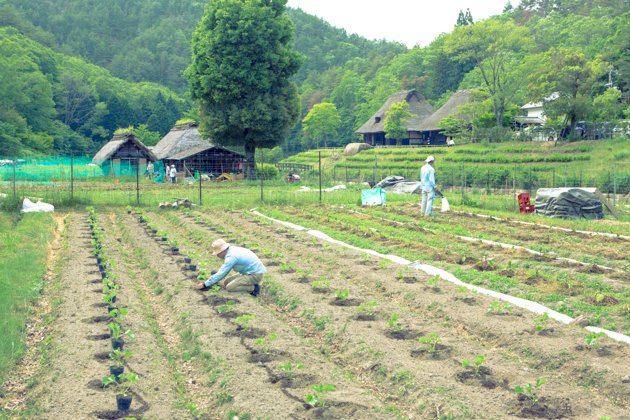Japanese Natural Farming - Chapter 1: Okada Mokichi and the Sekaï Kyūseï-kyō and Shinji Shumeï-kaï Religions
Japanese Natural Farming - Chapter 1: Okada Mokichi and the Sekaï Kyūseï-kyō and Shinji Shumeï-kaï Religions
(Original French version here)
The Japanese term shizen-nōhō, translated into French as “agriculture naturelle” or even “agriculture sauvage” (although in reality the term “nature-agriculture” would be more exact), dates from 1950, some 25 years prior to the publication by Fukuoka Masanobu of “The One-Straw Revolution: An Introduction to Natural Farming”, when it was used for the first time by Okada Mokichi (岡田茂吉 1882-1955) to designate an ensemble of agricultural techniques which he had himself developed in the ’30s and laid down in 1953 in his book ”Shizen-nōhō Kaïsetsu-sho” (自然農法解説書 Explanatory Book of Natural Agriculture). Having created in 1935 his own religion Sekaï Kyūseï-kyō (世界救世教 ‘Teachings for World Redemption’), Okada conceived shizen-nōhō as a means of redemption for humanity, a tool with which to recreate heaven on earth, explaining that “there is a relationship between the simple act of growing and consuming our food, and the greater question of growing a more peaceful world.” [cf. note 1]

The Sekaï Kyūseï-kyō religion still exists in Japan (in 2009 it counted 1,031,506 members)[cf. note 2] and owns among other sites the Shizen-nōhō Kokusaï Kenkyū Kaïhatsu Sentā (自然農法国際研究開発センター ‘International Natural Agriculture Research and Development Centre’) research facility in Matsumoto, a town in Nagano prefecture. Founded in 1985, this centre continues the agricultural work of its founder, but it is to another religious group — the Shinji Shumeï-kaï (神慈秀明会) — that shizen-nōhō owes its expansion.
Founded in 1970 by Koyama Mihoko (小山美秀子 1910-2003), the Shinji Shumeï-kaï religion had for goal to spread the teachings of Okada Mokichi and is recognised by Sekaï Kyūseï-kyō as a branch of the very same religion. Grouping together the entirety of Okada’s teachings on agricultural theory and practice under the banner shumeï-shizen-nōhō (秀明自然農法), Shumeï (as the group is commonly known) became increasingly involved and, on the occasion of their 1992 assembly, asked all of their faithful to actively participate in the development of the movement. The dynamic thus generated led to the creation twenty years later in October 1992 of the shumeï-shizen-nōhō netwāku (秀明自然農法ネットワーク), a network for the production and distribution of vegetables grown in accordance with the teachings shumeï-shizen-nōhō. [cf. note 3]

Photo taken from the website of Shumeï’s blog
Active today in all the different regions of japan, as well as in the United States, in Taiwan and in Europe, the Shumei organisation acts as the official ambassador of Japanese natural agriculture and is a real force to be reckoned with. As Charles and Perrine Hervé-Gruyer write in their book:
“according to Shumeï, the farmer can be the productive artisan responsible for a reconnection between our contemporaries and nature, the rhythm of the seasons, their bodies and their health, all using nothing more than the healthy elements that he produces. In the country that saw the birth of the “teikei” (AMAP in French [and CSA in English]), the very first partnerships between consumers and producers, Shumei works to establish a relationship based on mutual appreciation: consumers are grateful towards the farmers, whose work brings them healthy products, whilst the farmers are grateful towards the consumers, whose long-term commitment allows them to practice their craft with dignity.” [cf. note 4]
The network set up by Shumeï is both huge and little known in Japan because it depends almost entirely on the faithful: the lines which normally separate producer and consumer are broken down so that all members of the organisation are able to support — not only financially but also physically — each and every one of the farmers. A large percentage of the 300,000 members of Shumeï do not hesitate to go into the fields and lend a hand at busy times: in a report published on the website of the Rodale Institute, a highly-regarded organic agriculture research institute in the US, Lisa Hamilton writes:
“Japan’s 1,290 practicing Natural Agriculture farmers are rarely alone at the market or in the field. That’s because the consumers are also members of Shumei; equally devoted to agriculture as a spiritual pursuit, they break out of their ordinary vocational roles to practice their version of CSA (Community Supported Agriculture). Being a customer means not just buying the food, but organizing a CSA, helping to weed the rice paddies, and sometimes becoming farmers themselves.
Shumei consumers could be seen as a captive market, but really it’s the very concept of a market turned on its head; the lines that traditionally separate consumer from producer all but dissolve.”[cf. note 5]
note 1. Dena Merriam, The Message in a Seed: Guidelines for Peaceful Living (traduction Charles et Perrine Hervé-Gruyer dans Permaculture Guérir la Terre, Nourrir les Hommes, p. 157)
note 2. Wikipedia, 世界救世教
note 3. Hokazono Shingo & Ohara Kyotarō, 現代農業における「秀明自然農法」の意義 実践農家の技術と経営を通して, “農林業問題研究(第162号・2006年6月)”
note 4. “[s]elon Shumeï, le paysan peut-être l’artisan fécond d’une reconnexion entre nos contemporains et la nature, le rythme des saisons,leur corps et leur santé, par le biais des éléments sains qu’il produit. Dans ce pays qui a vu naître les premières formes de partenariat entre consommateurs et producteurs, les teikei, chez nous baptisés Amap, Shumei milite pour une relation fondée sur la reconnaissance mutuelle : gratitude des consommateurs pour les paysans, dont le travail leur procure des produits sains, et gratitutde des paysans pour les consommateurs, dont l’engagement dans la durée leur permet de vivre dignement de leur métier.” Charles et Perrine Hervé-Gruyer Permaculture Guérir la Terre, Nourrir les Hommes, p. 157
note 5. Lisa Hamilton, Farming measured by a different yardstick altogether, Rodale Institute
To follow: Chapter 2: The Descendants of Fukuoka Masanobu: Kawaguchi Yoshikazu and Takeuchi Atsunori
When he's not obsessing over heritage varieties of vegetables & herbs, chasing off wild deer or otherwise running around the fields of his mountain farm, he's trying to beat the system, taking photos or trying to better understand cryptocurrencies.
You can find his Steemit introduction here
You can find out more about his farm here: @potager-cerfs
We in Aceh (Indonesia), farmer is we job primery. We very enjoy and love of that job..
Yes, being a farmer is hard but one of the best jobs there is!
Thank you so much for putting this out in English, very inspirational. I really need to get on starting my own religion.
You mean you don't have one already?!
if you don't have any followers you are just crazy, if you have some followers you have a cult, when you have enough followers you have a religion
Same rule as for murderers, then, huh?! Sounds about right. Sure works for statism anyway...